#The writing style (hiragana)
Explore tagged Tumblr posts
Text
King of Prism 7th Anniversary picture book: Leo’s Favorite Things

Look what finally came! The King of Prism 7th Anniversary picture book! I have to admit... it’s a good deal smaller and shorter than I had hoped. But, it is adorable nonetheless and I’m happy to have preordered for the small chance to throw some money at King of Prism’s future. So, out of respect for the brand and other people who purchased it, my photos will be a little blurry.
The story is written from Leo’s perspective, and is written in a very simple, childish tone. He begins as though he is just making a list, but then switches to using full sentences a few pages in.
Leo’s Favorite Things

My favorite things.
Cute outfits.

Sweet treats.
And my friends.

When I’m feeling tired, I like chocolate!
Like after I’ve given my all at work or studying!

And donuts when I wanna eat a lot!
They are so soft and so, so sweet! Eating them with tea or coffee puts a smile on my face!

And tarts for when I really want to take my sweet time!
Fruit tarts, chocolate tarts, cheese tarts. There are so many kinds!

Let’s get all dressed up and eat them together!

So good! It’s even more delicious when we eat them together!
What a nice, relaxing, happy time!

And finally, macarons!!
Each color holds a different happiness!
Which color shall I try today?

Spending time with everyone just like this is my number one favorite thing!!

#king of prism#kinpri#The writing style (hiragana)#combined with the art style of the boys wearing performance uniforms randomly#has the same energy of the precure picture books and magazines for preschoolers where they hang out while transformed
23 notes
·
View notes
Text
Okay can someone who speaks Japanese fluently or something explain why “control your heart” isn’t explicitly romantic I’m begging atp
I’ve been silent for too long. Am I just too autistic to get this saying??? I thought the heart = romantic so someone who’s got a damn clue about how this works pls explain.
Is “the heart” referring to general deep feelings in Japan? I know Japanese is a generally more “flowery” language because it can say a lot more metaphorically with its vocab, yada yada whatever. I just need someone to explain this or else I’m just gonna keep asking people to explain why the heart doesn’t refer to romantic feelings.
#begging atp#please#bkdk#midoriya izuku#Japanese#hiragana#I forgot what the other writing style is called#pls help I only know English and some Spanish please
32 notes
·
View notes
Text

Ad from 1950’s Japan: 1959 "cotton mumps" ad sourced from Japanese blog “ Retromaniagogo ”
(If any Japanese peeps want to translate the ad it would be very much appreciated! The info provided is all I could find about it. Feel free to correct if needed!)
#vintage#vintage ads#vintage advertising#japanese ads#Japanese ad#1950s ad#1950s style#1950s Japan#japanese style#Japanese vintage#vintage japan#vintage Japanese#1950s#hiragana#katakana#kanji#japanese writing#japanese words#japanese characters#goldfish#black goldfish#goldfish drawing#fish drawing#vintage aesthetic#vintage drawing
17 notes
·
View notes
Text
How to Kick Ass at Worldbuilding

Worldbuilding. You either love it and spend all your time dreaming up rules rather than writing, or you hate it and try your best to avoid it despite writing fantasy or scifi.
Or you are in the middle, which is where you should be. You have a healthy appreciation for what makes worldbuilding so special, but you also don't obsess over it.
Worldbuilding does not need to be complicated to be effective, as I've harped on a few different times now. So how do you strike the right balance? Let's take a look.
As always, this is just my opinion based on my own efforts creating The Eirenic Verses. You can disagree and that is fine. However, I hope you'll consider thinking about what I offer here as you craft your own world.
A lot of what people focus on when worldbuilding is not what the audience cares about.
Very few people like to read a book littered with random terms they have to keep track of. We want to build a unique world, but we also don't want to throw such an extreme amount of lore at our readers that they tune out.
When worldbuilding, we want to consider the cognitive load on our audience. This is how much information the reader needs to remember throughout your story so that they can follow along.
Cognitive load includes things like:
Character names and appearances
Relationships between characters
Place names, such as cities and countries
Unique mythological creature or fauna
Backstory, including mythology and folklore
Language names
The general plot (who is the protag, who is the enemy, etc)
Magic usage (who has the power, how they acquire it, any conditions it comes with, etc)
Power dynamics between characters, countries, and so on
Political systems, if included
Even in the most barebones fantasy story, this is a lot to remember. As such, we need to consider what is most important for our readers to generally understand the plot and emphasize this, letting the rest serve as background information that is not quite as essential. The more emphasis we put on something, the more we direct a reader's attention.
At the same time, we want to create a world that feels lived-in and interesting so that readers want to know more. How do we do this?
Consider what you think about foreign countries in our world.
Most of us will have a general concept of a country but only will think about the specifics if it is currently relevant.
Let's take Japan for an example. (I'm a bit of a weeabo, okay?) Here is what I personally think about when I imagine Japan, in order of what I consider important.
Japanese cuisine (sushi, ramen, ochazuke, sake, lots of rice dishes, seafood)
What the people are like according to my own stereotypes/cultural perceptions (polite, quiet, respectful, hardworking, punctual)
Climate and geography (temperate, island country, volcanos, mountains, beaches)
Unique flora and fauna (cherry blossoms, flowers, Nara deer, giant salamanders, pretty birds)
General landmarks, but not necessarily specifics (castles, temples, busy cities, red bridges, torii gates)
Clothing styles (kimonos, school uniforms, business suits, kawaii fashion)
Cultural icons (samurai swords, samurai armor, Shinto shrines)
General overview of the history (samurai, daimyo, feudal system, bushido, Meiji restoration)
Language, but not necessarily specifics of the language (Japanese, kanji, hiragana)
Religion (Buddhism and Shintoism)
Folklore (ghosts, kami, tsukumogami, evil spirits)
Any festivals I might know of (cherry blossom festivals, moon viewings, Obon)
Your own list may have these in a slightly different order, but it's probably what you most think about.
Notice that you will likely not think about these things:
Political system
Specifics of the language
Interpersonal hierarchies
International relations
Specific landmarks
Specific historical events
Famous figures
So why do we think like this? Because in real life, we also have a cognitive load that we must balance with things that are more relevant to our everyday lives.
If I tried to memorize specific details of every country in the world, I would go insane. I have better things to do, so I create a general image of a country based on pictures I've seen, people I've met, food I've eaten, and so on. You do the same thing.
To be realistic, you do not need to be specific. You need to approach worldbuilding the same way people generate their world knowledge: basic concepts and visual imagery.
What to emphasize in worldbuilding
So let's break this down on what you want to think about when creating a world.
Food is one of the most accessible elements of a culture.
Food is how many people learn about different cultures for a simple reason: if you have the ingredients, you can cook food from anywhere. You don't need to be introduced to it by a native of that culture.
Plus, humans tend to like food. We kind of need it to exist.
Think about these things when considering national cuisines and eating habits of your fantasy world:
Do they have spicy food? Bland food? Heavy hearty dishes?
Is most food served hot or cold?
What kind of spices and vegetables do they use? Root vegetables, beans, cinnamon? Salt?
What type of meat do people eat (if any)? Seafood, poultry, beef, pork?
How is bread prepared? What is it made of? (Look, nearly every culture has some sort of bread, we love carbs)
What about pasta? Does that exist here?
Are desserts important? What are they made of?
What kinds of drinks do they have? Coffee, tea, milk, lemon water?
Is alcohol a thing? What kind of alcohol? How often do people drink? Are there bars?
How often do people eat, and when? Do they have the typical three square meals, or do people eat kinda whenever they feel like it?
Do people prepare food at home or are there restaurants?
Are communal dinners common?
Cultural stereotypes provide tension and can help craft your characters.
Are people in your culture known for their boldness? Their cunning? Their resilience? Their standoffishness? Their fiery tongues, or their passive-aggressive jabs?
You can play with a lot of this, either confirming or denying the assumptions through your characters.
Landscape gives us an idea of where we are and what to expect.
Landscapes are some of my favorite aspects of worldbuilding rather than intricate magic systems and political concepts. Readers get a good sense of environment when you focus in on landscape and how it impacts the characters. You can also build a culture off your landscape, such as how certain geographic features may influence peoples' attitudes and lifestyles.
For example, a coastal landscape will have beautiful views of the ocean, sparkling beaches, and maybe tall cliffs. Being a fisherman may be seen as an honorable but dangerous profession. People might cliff dive for fun.
Mountainous areas may produce cultural enclaves, especially in a fantasy setting where everyone is more isolated. One mountain town may have a completely different vibe than the town over.
Flat, wide-open plains mean people can spread out, but since moving from one place to another is easier, there may be a more cohesive culture.
An area with caves will have a sense of mystery and fear; there may be a lot of superstitions about the caves.
A swampy area can also be very mysterious as there are so many places to hide out and a lot of dangerous animals.
Climate influences how people behave.
Hot climates make people need to conserve energy, so they may take afternoon naps in the worst of the heat. They might value relaxation and calm over industry and productivity because bro, have you ever tried to even walk outside in the Florida heat? Shut up and get me air conditioning.
Cold climates make people need to stay active to stay warm, but they can also produce a sense of isolation. Think about how outdoorsy the Finnish are but how they looove their personal space.
Temperate climates are probably a bit more even-tempered, but as weather changes get more extreme, people will vary their behaviors based on the seasons: spending more time outdoors during summer but holing up during winter. The culture may emphasize hospitality because people need to rely on one another to survive, and they have time to meet their neighbors during the summer.
I am very partial to temperate climates, being from the American Midwest. We're known for being nice and hardy people. You should come visit.
Flora and fauna help the world feel real.
When I worldbuild, I often base my cultures on a real place and what kinds of animals or plants are there. For example, Breme is based on Mongolia so I have herbivores, big raptors, and a lot of grasses.
A warm climate will have lots of reptiles. Sea life will be important in a coastal area. Swamps might have big predators. Mountains will have hardy creatures that can climb. A savannah area will have huge herbivores and fast, hungry predators.
General cityscapes or villages are great for providing a sense of place.
Do people build low spread-out cities or tall rickety homes? What kinds of building materials do they use? Are there lots of markets, bars, apocetharies, temples or churches? What do homes look like here? What are any unique architectural features?
This gives a sense that we are in a different but specific world that has a rich culture.
Clothing tells us what people prioritize.
Cold places will have lots of layers. Hot places will have soft draping outfits or very skimpy outfits. Natural materials that are easily available will make up the majority of the clothing in a fantasy setting. You wouldn't have people wearing cotton in a place that doesn't grow cotton. If there are lots of sheep, people will wear wool. If there's lots of cattle, people will wear leather.
You can also think about adornment. Is jewelry common? What type? Why is it important? Is it a status symbol, a way to keep wealth, or perhaps ways to honor ancestors?
Cultural icons demonstrate what the society values.
A warlike culture will prioritize weaponry. A pacifist culture will think about art and music. A nomadic culture may have a rich oral tradition. An agrarian society will emphasize farming rituals.
Think of a few things that symbolize your society, whether that's musical instruments, weaponry, textiles, statues, or jewelry. Consider how those traditions could have come about and why.
Folklore and mythology offer an offbeat but important sense of history.
Folklore is often tied up with many other factors of a society, such as their religion, landscape, history, and overall values.
For example, the Japanese believe items survive for over a century gain a kami, or spiritual essence. This shows that the Japanese cherish their long history and their material culture, and it also infuses their Shinto belief into folklore.
You can also think about cryptids or ghost stories. Isolated and difficult terrain often makes people think of monsters lurking in the woods. Areas with lots of caves will have myths about what is down there. Coastal areas develop myths about ghost ships.
Idioms, turns of phrase, and gestural quirks tell us more about the culture without overwhelming readers.
This one can be more challenging (I haven't done much with it) but if you can manage it, you'll have a very rewarding story.
I'm not talking about making a whole new language here, but rather about idioms and turns of phrase. Think about all the fun idioms that English has, like "beating around the bush" or "break a leg." Without cultural context, you can't understand them, so you'll have to incorporate an explanation without actually stating it.
For example, you can have a character say "the horses are running fast" as they look out the window to see a sheet of rain. We can guess from this that the idiom is rain = horses, so lots of rain = fast horses. We'll understand from this that this culture probably loves horses; maybe they're a formerly nomadic race.
Gestures, like whether people give thumbs-up, point with their index, or bow with their hands to their chest all give us a feeling of the culture without being overwhelming.
What not to emphasize
Now that we've gone through some things to focus on, let's talk about what you don't need to make up for your world.
A whole-cloth language
Please, you don't need to create brand new words for things that exist in our world. You can reference a language, but do not make people memorize nouns they don't need.
Don't even make up the language at all. Say there's a language and then write the rest of it in English.
Made-up languages are irritating for readers because they want to focus on the characters and plot, not mysterious words they need to translate.
It's possible to make languages interesting without going into specifics. For example, the Bas-Lag trilogy by China Mieville has a species that communicates in clicks but the species can also learn human languages if necessary. There's a language called Salt that's basically the common tongue blended from everything else.
Do we need to know how Salt works? No. Doesn't matter. We're told someone is talking in Salt, or they're learning it, or they switch to it when meeting someone from a different culture. That's plenty.
Specifics of a magic system
You're not going to instantly summon up all the rules of magical realms when you visit a new country; you might not even know them. And your readers won't be too interested in them either.
For example, in The Eirenic Verses, I have High Poetry. Readers will come to know that this was a magical system where certain people given the power can recite a poem and whatever they speak comes true. Every poem can only be used once.
It was given by the goddess Poesy to a specific woman, Saint Luridalr. It was so successful that the goddess started giving it to more women and a whole religious system arose.
I don't need to explain exactly how it works because no one cares. Someone makes things happen by coming up with a poem: that's about it. We don't need to question whether certain rhyme schemes or meter or punctuation impacts anything. That's too technical.
If you've got pages and pages of notes on all the intricacies of the magical system, you have too much. Pare it down.
Political systems
Unless you're writing a fantasy where politics are absolutely critical to the plot, you can just reference the political system in passing and maybe elucidate a few key elements, like who the leader is, how power is transferred, etc. You don't need to go into all the specifics because most people are not going to care.
Hierarchies
Please don't lay out the entirety of an army's ranking system or how someone is promoted. Make up something consistent and stick with it, but don't go into exhaustive detail. People aren't going to sit and question whether a captain is above a lieutenant or how long it takes to become a general.
We'll know that a general is a big deal if the characters make it a big deal. We'll know who the head of the army is but we don't need to know how they got to that position.
Exact city layouts
You do not need to tell us where everything is in relation to one another. Tell us characters are moving from one landmark to another. You could say "this is across a bridge, this is up in the mountains, these buildings are right next to one another, these two buildings are in opposite ends of the city." That's plenty.
If somewhere is very far away, just show them travelling there and how long it takes. You don't need to measure it in miles or leagues or whatever. We will guess that if it takes them a week to walk there, it's pretty distant.
Economic systems
We just need the basics here: mercantile, capitalist, bartering, etc. We don't need to know if the coinage is pegged to a certain precious metal or if people invest their money or how people are paid. That's boring.
In my world, I have two currencies: quillim for Breme and barnals for Sina. What's the exchange rate? I don't know and don't care. How much is one quillim worth? One quillim is not a lot but 2,500 quillim is. How much is the average person paid? Doesn't matter. Do people keep lots of coins on them? No one is asking that. It's not important.
Transit systems
Tells us if the roads are cramped, spread out, nonexistent, poorly maintained. Tell us if there are road blocks or toll booths. Tell us if there are roving bandits. The more physical and sensory you can get, the more real it feels.
Few people care about the specifics of even their own transportation system. I know highways are fast, I know tollroads are expensive, I know parkways are pretty, I know some cities have weird turnabouts and dead ends. That's exactly what I need and what I care about.
That's what I've got for you today. If you liked this, maybe you'll consider checking out The Eirenic Verses series, which follows most of these principles.
I've been told that my fantasy writing is very approachable, even for those who don't usually like fantasy, specifically because I don't get too insane with my worldbuilding. So maybe you'll enjoy it too!

#fantasy worldbuilding#worldbuilding#fantasy writing#fantasy writer#writing community#creative writing#writeblr#writeblr community#writing on tumblr#writing opinions#am writing#writers of tumblr#writer stuff#how to write#fiction writing#writing advice#writing tips#writing resources
127 notes
·
View notes
Text
Who Wants To Talk About Japanese Orthography In Manga???
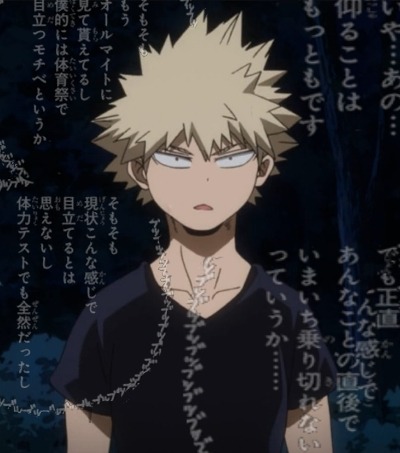
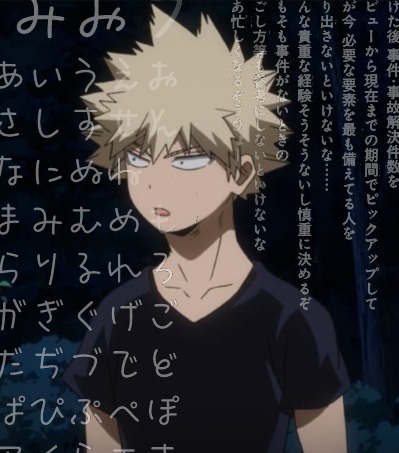
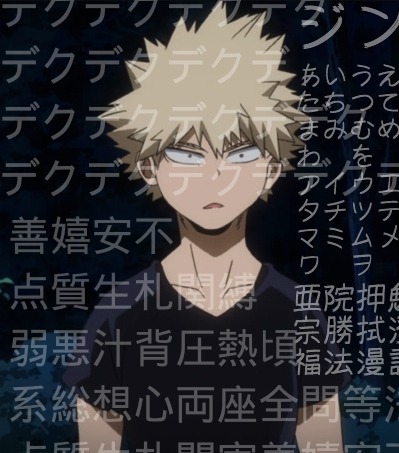
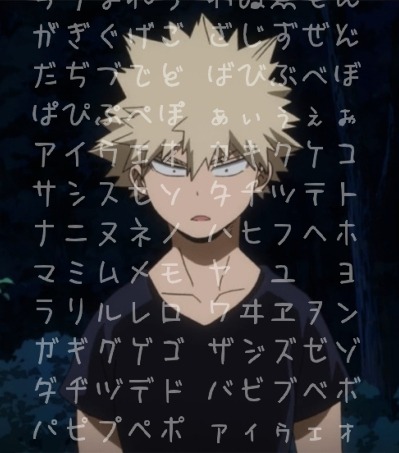
Me, it's me, I do, and I have been chomping at the bit to get the chance to.
Orthography refers to the conventions of written language to represent sounds. That may bring to mind the idea of rigid grammar rules or spelling standardization, but in a linguistic sense, orthography simply describes observable trends across language use. This isn't about authority--I am not going to talk about what schools teach or say people should write one way or another. This is about examining how real people use written language creatively to convey different things in popular media.
This is a huge topic, so I'm only going to use examples from MHA to highlight Horikoshi's style.
First, let's get a run-down of the main parts of written Japanese and how they tend to be used.
We've got kanji and kana; kanji are logograms, while kana are syllabaries. Kana refers to both hiragana and katakana collectively, but we will delineate the two from here on.

The Wikipedia page for kanji, describing this more succinctly than I'm about to.
For clarity, I'm gonna color-code each one.

Let's take a quick look at all three in action.
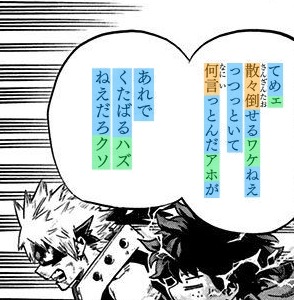
Chapter 65
By virtue of being the syllabary that grammar particles are written in, hiragana can get away with a lot that kanji and katakana can't.
You can write simple sentences in hiragana alone, like so:
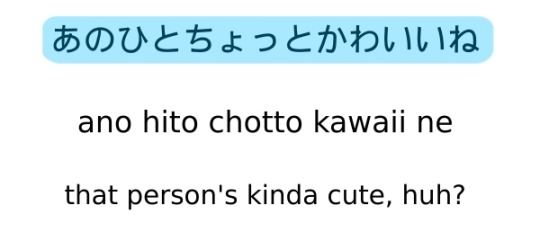
The sentence is perfectly comprehensible like this, but it reads as casual or perhaps a bit immature, like the person is either leaving out kanji for speed or simplicity (like online) or they aren't confident using kanji. Although, the word hito (person) is extremely common and its kanji is simple, so this would probably look more natural:

But there are also kanji for the word kawaii, so you could also write it this way:

On the other hand, writing the whole thing in katakana looks weird as fuck:

bECAuSE iT kINDA reADS LIKE THis, or maybe L I K E T H I S
It seems almost alien, overemphasizing the phonetic sound of the words, implying there's something notable or unusual about them.
But what if you write it like this?

Both ways use katakana to put flavor on a specific word. The first puts it on person, which could be used in a situation where someone hasn't been named yet, but the speaker tonally emphasizes your knowledge of them--like "oh, you know who."
The second emphasizes cute, which could read as sexually suggestive, teasing/joking, or even a threatening tone, depending on the context. "Real cute, ain't they?"
Basically, the connecting grammar bits need to be in hiragana, but nouns, verbs, and adjectives can typically be written in any of the three systems. That introduces choice into the matter, and these choices may have some cultural connotations.
This is a subtlety in written Japanese that manga loves to take advantage of. Orthography contributes a lot to characterization and tone, so individual creators develop little quirks as part of their own writing style.
Now let's finally take a gander at some of Horikoshi's!
Kanji instead of hiragana for semantic emphasis
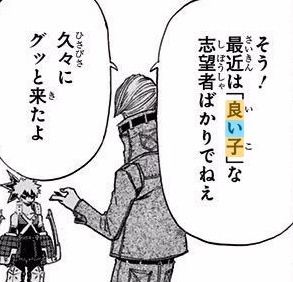
Chapter 48
Best Jeanist could have used only hiragana for the word "good" (いい, ii), which is a very common way to write it. But he's not just commenting that they are nice kids, he's talking about them as "goodie two-shoes" and even puts brackets around the idea. The kanji emphasizes the cultural idea of a Good Child™, a well-behaved, morally upright, obedient young person.
Kanji instead of hiragana denoting a serious or severe tone
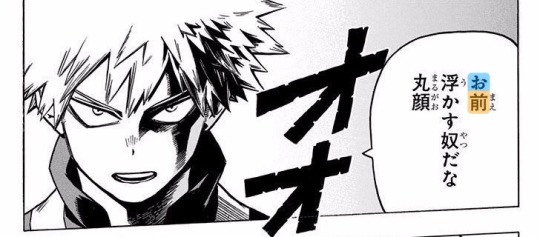
Chapter 36
Katsuki's "you" pronoun omae being written with kanji comes across as markedly serious, especially compared to how his dialogue is normally written. This is actually the only time Katsuki says omae and it is written with kanji--all the rest are in hiragana, which tends to read as more casual.
Hiragana instead of kanji denoting a gentle tone or youthful/childlike language
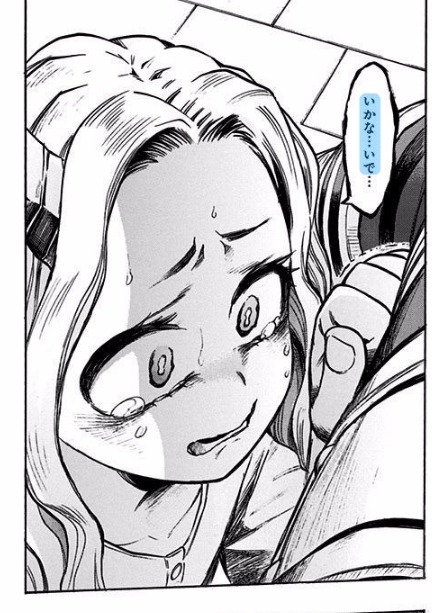

Chapters 129 and 183
Katsuki and his omae show us how kanji use can be seen as more mature and serious; Eri's dialogue does the opposite of this by using hiragana when it could use kanji, emphasizing her youth and innocence.
Katakana instead of hiragana or kanji for emphasis or slang
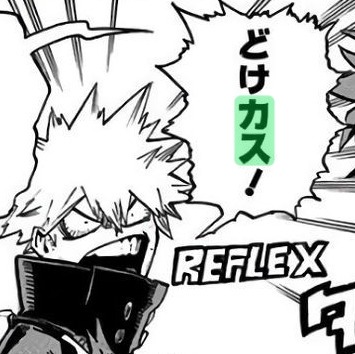
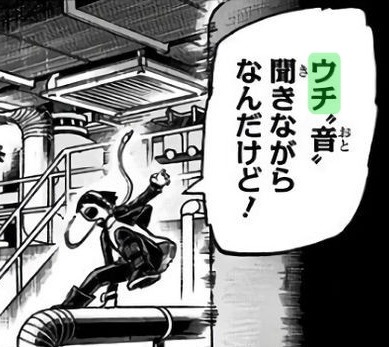
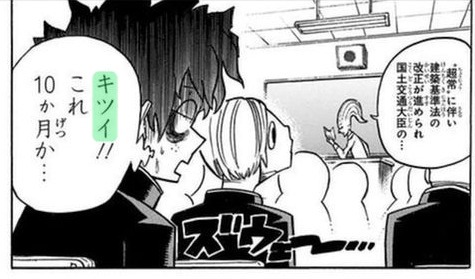
Chapters 209, 207, and 2
As I detailed above, one of katakana's most common uses is similar to italics or all-caps.
But you also tend to see slang written with it, and depending on the slang, the word being in katakana can immediately clarify it from other, perhaps more standard meanings. In Jirou's case, her personal pronoun uchi can mean a couple other things, so it being written in katakana clarifies her usage. It could arguably also imply she is taking a bit of an argumentative tone--Katsuki's slang is typically written in katakana for both of these reasons!
Katakana denoting regional dialect/accent, nonstandard pronunciation/muddled speech, or confused articulation
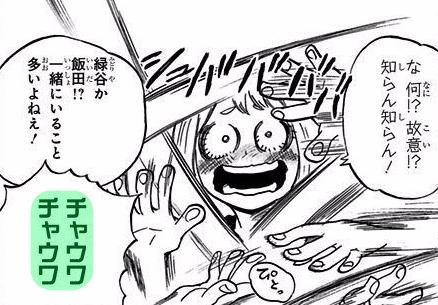
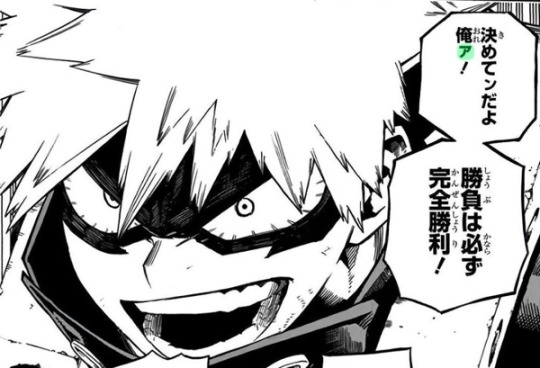
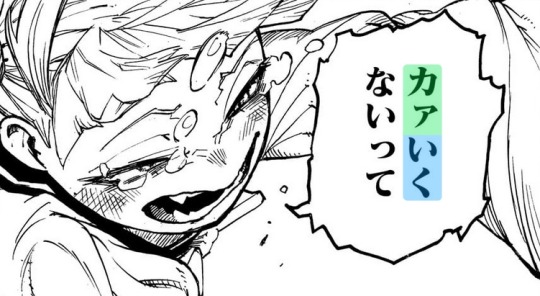
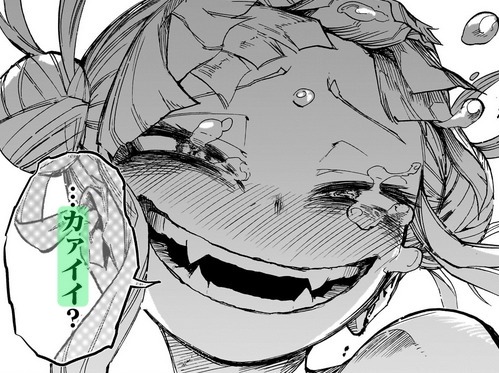

Chapters 102, 208, 394, and 2
Ochako gets flustered and defaults to her regional Kansai dialect. Instead of "chigau wa" (Tokyo dialect), she says "chau wa" repeatedly.
Katsuki and Toga both drop the w- sound from a word. Katsuki says "ore a" instead of "ore wa," while Toga says the word "kawaiku" as "ka'aiku" and "kawaii" as "ka'aii." Notice how the katakana which represents the vocal omission/hiccup is actually smaller than the others? That's also a little stylistic detail for communicating this kind of nonstandard speech.
Izuku repeats All Might's words, chikara wo, in a confused daze because he isn't following All Might's point. By removing the kanji especially, this kind of katakana emphasizes him sounding the words out without recognizing the underlying meaning.
Basically, Japanese has some excellent ~vibes-based~ orthography because of how the language is structured!
Of course, you find this kind of thing in English as well--especially in the age of the internet, where people note that "how dare u" reads as tonally distinct from "how dare you." As you develop language fluency, you tend to pick up these things subconsciously more than anything, but it's one of my favorite things to analyze and compare.
These are just a few examples and my own interpretations of them. I'm sure there are many more uses and flavor-nuance I'm not picking up on. Since any given choice can be read a few different ways, context is very important. My examples aren't definitive proof of anything, but it can be fun to keep these kinds of details in mind while reading.
Shueisha and Shonen Jump surely have in-house standards for text, and mangaka must operate within that range. That said, I have indeed seen every one of these examples in other manga as well.
And on the independent side of things, doujinshi and online manga are basically the wild frickin' west--I have seen tons of totally crazy, highly creative ways to take advantage of the unique flexibility found in Japanese, but that's a post for another day.
I will probably write more about this kind of thing in the future when I can pinpoint some more observations, but I hope you all enjoyed the ride. <3
#meta#linguistics party#this is the nerdiest shit I've ever written and I'm not sorry#I find this soooooo fascinating and fun to think about#people are so cute we think of all kinds of ways to properly convey ideas and feelings and reference shared cultural information#almost all human languages are first and foremost spoken out loud#and human beings get so creative trying to figure out how to express all the complex minute details contained within verbal communication#through the written word#mha 2#mha 36#mha 48#mha 65#mha 102#mha 129#mha 183#mha 207#mha 208#mha 209#mha 394
175 notes
·
View notes
Text

When your reincarnation/Nepobaby is taller then you.
P.S I've decided to call my Destined One "Meshi" since it means 'cooked rice' in Mandarin. Goku named his son Gohan, which is rice in Japanese so I thought it was cute!
P.S.S RIP Akira Toriyama
Edit - Japanese and Chinese are very complicated languages. There's about 7 different ways to say 'I am hungry' in each. So! Correction, in Hiragana, a Japanese writing style, "meshi" means rice and also "gohan" in Kanji, another type of Japanese writing style, also means rice. I wanted to correct myself.
Edit no. 2 - "Mǐ' is uncooked rice, "fàn", is cooked grains of rice, and "dào" is rice plant all in Mandarin. Still sticking with Meshi cuz by now I've gotten used to it and it sounds cute!
76 notes
·
View notes
Note
Ah hello. Did you know in the T1 script book John Doe 009 VD, when 09 introduces himself, "Mikoto Kayano" personally introduces himself with the kanji spelling of his name but its alternative reading (furigana) is in katakana, not hiragana. He is the only prisoner that introduces himself in full with an alt spelling in katakana rather than Es imparting or calling a prisoner with their katakana code name in the beginning.

The speech style he has here also matches the speech style in Neoplasm where Boku was using gobi due to the usage of the particle 「さ」。(I've written a speech style analysis of 09 before but I'll have to find the notes again. I'll likely send a follow-up ask or something ^^')
This has me thinking about one of your previous posts which brought up the possibility that Mikoto "boku" Kayano, or, how others say, 🔵 and 🟢koto, don't realize that they're separate identities.
「ボクが僕を救ってあげましょう」 <- these bokus
There's also the possibility that when people have been referring to 🔵koto, they've actually been meaning 🟢koto this entire time. So are color code[name]s appropriate for 09 anymore? (/rhetorical)
What do you think? Any changes in how you perceive 09? I look forward to seeing more of your really cool analyses or thoughts on him.
Hello! Thanks so much for the ask! I did not know that; super interesting that it's unique from the other introductions. What you pointed out here is actually so intriguing, thank you for sharing your knowledge!
I have been wrestling with this for some time now because it's truly a case of "Schrodinger's Alter"; we have several instances that seem to indicate 2 "boku"s, but when they're speaking without the pronoun visually accompanying it, there's no gurantee of which one is fronting in any given interaction (let alone if a completely seperate alter is masking as "Mikoto," which is unlikely because writing that would get complicated, but not impossible).
Telling them apart is likely as difficult for them as it is for us given the amnesia; however, we don’t get insight into these things without the narrative explicitly stating such. This is interesting to me because this uncomfortable ambiguity is how systems operate in daily life, sometimes even amongst ourselves.
While color codenames have lost their usefulness to me personally, colloquially I find it helpful in discussing basic theories (and even tho it's gimmicky I've just personally liked the concept); that said, for all we the audience know, ボク ("Mido") and 僕 ("Miko") could be interchangable alters in the narrative; people may very well be referring to ボク as 僕 or vice-versa in any given interaction that John isn't around.
As far as changes in perception, it's dawning on me more and more how little we know about "Mikoto" (僕 or otherwise) as an individual in his system. He's high-masking as it is, but on top of that, we have no real way of guessing which alter "he" is at any given time unless they give an indicator. It's just simplest to assume 僕 in most cases. In the case of 俺, he's an easy guess only because he is made outwardly distinct by the narrative in both speech pattern and attitude. If there is a third, we may see glimpses of them in hindsight, but either way "Mikoto" (僕) as an individual alter is yet to be known as his own person beyond his passive, "professional" demeanor.
Tbh it's giving me insight into why a system host may be widely "liked" while remaining relatively or even completely unknown as an individual person. The demeanor shown by 僕 and his desire to be popular further shows that his sense of self is purely dependent on others' perceptions of him, which is as expected as it is tragic. I think if there is a third, we're gonna see a resigned, perhaps even apathetic tone from them; the system all tried so hard for seemingly nothing. I think the more 僕 tries to disappear, the more the other could realize their place alongside John in the system, if we explicitly see ボク at all.
It's all very ambiguous so I don't get really care how others label them, but I'm near certain that "僕" is not always who we think he is. (In John's case, I typically use his name rather than his pronoun bc even if he picks a more suitable name for himself later on, I feel strange using a first-person pronoun in place of a name when he has one; in the case of "僕" Mikoto, I do find it a necessary distinction from "ボク" given the ambiguity of it all, and it's more solid than color theory imo.)
This is all just my personal conjecture on how they are writing the system. It's definitely a kind of narrative I never thought I'd get to analyze, so I'm so happy to have others to discuss with! Thanks again for the ask. I'd love to see the follow up w the speech style analysis! I love yapping w you about the little guys 🙏
22 notes
·
View notes
Text
Tips for Learning Japanese for Beginners
Learning Japanese can seem like a daunting task, but with the right approach and resources, it can also be a rewarding and enjoyable experience. Whether you're interested in Japanese culture, planning a trip to Japan, or looking to expand your language skills, here are some tips to help you get started on your Japanese learning journey.
1. Start with Hiragana and Katakana
The Japanese writing system consists of three scripts: Hiragana, Katakana, and Kanji. For beginners, mastering Hiragana and Katakana, the two phonetic alphabets, is essential. These scripts form the foundation of the Japanese language and are used in most basic texts. Practice writing and reading them daily until you become comfortable.
2. Learn Basic Phrases and Greetings
Begin with simple phrases and greetings to build your confidence and start communicating right away. Phrases like "こんにちは" (Konnichiwa - Hello), "ありがとう" (Arigatou - Thank you), and "さようなら" (Sayounara - Goodbye) are great starters. Use these phrases in context to help them stick in your memory.
3. Utilize Flashcards
Flashcards are a great tool for memorizing vocabulary and Kanji. Regularly reviewing flashcards will reinforce your memory and help you retain new words and characters. However, traditional flashcards can be time-consuming and overwhelming. Consider using electronic flashcards or spaced repetition software to make the process more efficient.
4. Immerse Yourself in Japanese Media
Surround yourself with the Japanese language as much as possible to improve your listening and speaking skills. Watch Japanese TV shows, movies, and anime, or listen to Japanese music and podcasts. Try to mimic the pronunciation and intonation of native speakers. Additionally, consider finding a language exchange partner or taking a conversation class to practice speaking.
5. Learn Kanji Gradually
Kanji can be one of the most challenging aspects of learning Japanese, but don't be discouraged. Start with the most common and basic Kanji characters, and learn them gradually. Practice writing and using them in sentences. Associating Kanji with their meanings and sounds can help you remember them more effectively.
6. Delve into Japanese Culture
Understanding Japanese culture can deepen your appreciation and comprehension of the language. Learn about Japanese customs, traditions, and history. Try cooking Japanese dishes, practicing calligraphy, or participating in cultural events. This cultural immersion will make your language learning journey more enjoyable and meaningful.
7. Embrace Patience and Consistency
Learning Japanese is a marathon, not a sprint. With dedication, practice, and the right strategies, you can make steady progress and achieve your language learning goals. Set realistic expectations, celebrate your achievements, and don't be afraid to make mistakes. Remember, consistency is key to long-term success.
Additional Tips:
Find a learning method that suits you: There are many different ways to learn Japanese, so find one that fits your learning style and preferences. Consider taking a Japanese language course, using online resources, or hiring a tutor.
Set realistic goals: Set achievable goals for yourself and break them down into smaller, more manageable steps. This will help you stay motivated and track your progress.
Make it fun: Learning a new language should be enjoyable. Find ways to make learning Japanese fun for you, such as watching Japanese movies or listening to Japanese music.
Don't be afraid to make mistakes: Everyone makes mistakes when they're learning a new language. Don't let this discourage you. Instead, view mistakes as opportunities to learn and improve.
Immerse yourself in the language: Surround yourself with Japanese as much as possible. This will help you to learn the language more naturally and quickly.
Learning Japanese can be a challenging but rewarding experience. With the right approach and dedication, you can achieve your goals and become fluent in Japanese.

17 notes
·
View notes
Text
There’s a house in the suburban parts of Seasoning City, just by the outskirts of the city. It is three stories tall, blending a traditional minka style with the (fairly beige) modern design. There’s a plaque by the side of an overflowing mailbox. Hanazawa.
There are stone steps lining the pathway to the entrance. There’s a shoe locker by the genkan, with multiple unused slippers of varying sizes. A coat of dust lines each room.
Speaking of the rooms, on the second floor is the first bedroom. The people in this room have rarely slept in it. Its mattress has hardened and the sheets have never been changed. The door hinges creak when opened, though the instance was rare. The room’s been abandoned before the house was abandoned. There is an extra layer of dust coating it.
But we’re not here to talk about that bedroom. We’re here for the one on the third floor. It takes up most of the space. It has childhood anime posters on the wall and peeling glow-in-the-dark stars on the ceiling. It has an outdated TV and a pink patterned carpet.
This is our focus: the markings by the doorframe. The first one comes at around 73, 74 centimeters. It is unsure how tall exactly. The person being measured must have been all too excited to stay still. The text beside it is written in kanji, with delicate, graceful strokes: Teruki, 1 year old.
There’s one above it, a few centimeters taller: Teruki, 18 months. Then, Teruki, 2 years old. Up until 3 years old, it stays the same. Same pen, same handwriting.
At age 4, the text changes, though it doesn’t seem to want to. The line drawn on 99.5 centimeters is a shaky marker. The text beside it seemed to attempt the delicate kanji of the previous writer, but lacked the skill to do so. The attempt was crossed out in frustration. Written next to it is a blocky Teru, 4 yeers old in hiragana.
This continued on for a few months until the writer learned to write his name in kanji. Still in chunky and big handwriting, the Teru turns to Teruki. The markings ascend from 111 to 119 centimeters. It goes on and on. Sometimes, it’s neither the delicate nor the blocky handwriting. Sometimes it is someone else entirely.
Scratchy with pencil but careful with the strokes, as if the house wasn’t their own. They write Teruki Hanazawa :) beside the measurements. This writer is sporadic in their appearance, but they’re still a presence throughout the markings, even more so than the first.
Years go by. The blocky and the scratchy writer seem to take turns.
The final marking on this door frame is at 148 centimeters. It is labeled in katakana, Teru, 12 years old.
There’s a similar chart to this in a random apartment in the heart of Seasoning City. The markings on the door frame of this is merely replicated from a picture of the last. It continues where the chart leaves off. The next installment is a strange addition.
Teruki, 13 years old - 188 centimeters.
Now, such a growth spurt is improbable for this specific person, but that was not what he was tracking exactly. He had decided, while in this apartment, to track how he feels how tall he is. It’s not a prediction but a mere externalization. The apartment he has is actually not big enough for him, despite its space. He is a giant. He is vast and he is mighty.
Teruki, 13 years old is written in delicate, graceful kanji. It tries to be his mother.
—
For #TerukiWeek2023 on twitter!! the first prompt was growth :D
188 notes
·
View notes
Text
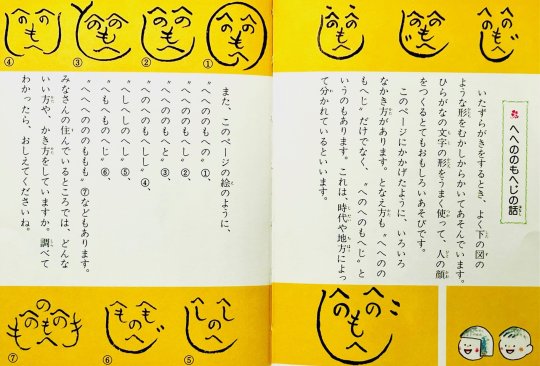
Satoshi Kako, fascinated by the art of drawing, collected more than 100,000 documents from all over the country over half a century and compiled them in his book 'Densyou Asobi-ko' (The idea of folklore play). A small selection is introduced in Satoshi Kako's Hello Storytelling, February Issue.
(Right page) The story of "hehe no moheji" When drawing pranks, we often play with the shapes shown below, which we have been writing for a long time. It is very interesting to make a human face using the shapes of the hiragana characters. As shown on this page, there are various ways to draw them. The way of chanting is not only "heno heno moheji" but also "hehe no no moheji". This is said to vary according to time period and region.
(page left) Also, as in the picture on this page, (1) "hehe nono moheno". (ii) "hehe nono moshito" (iii) "hehe nono moheto" (iv) "heno heno moheshishi" (v) "heshi heshi noheshi" (vi) "Hemo hemo noheshi" (vii) "hehehehe nononono momomo" There are also some other words. What kind of language and drawing styles do you use where you live? If you find out, please let us know.
絵描きあそびに魅了された加古は半世紀にわたり10万件以上の資料を全国から集めて『伝承遊び考』にまとめました。『かこさとし お話こんにちは 2月の巻』には、ごく一部が紹介されています。
36 notes
·
View notes
Note
Don’t remember if I’ve sent this ask before but just want to say I practice hiragana and katakana reading with your comics :D also your art style is awesome
Ah I'm happy to hear that my Japanese helped you a lot!
わたしの にほんご が、やくにたったようで うれしいです!
I also practice reading and writing English with this site. So I want to say thank you, too!
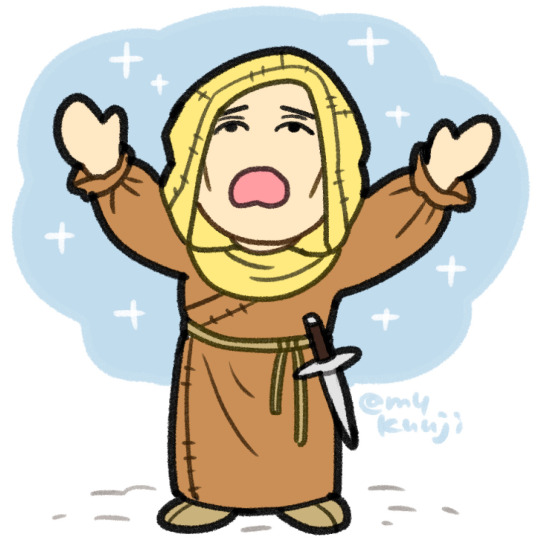
31 notes
·
View notes
Text
31 Days of Productivity Reading もう一回!: Day 10
Before: I don't have a proper before, since I didn't get to write anything before I started reading and I just needed to finish ポーの一族 today anyways. But I can still tell you about my day before I started reading! I usually run errands on Saturdays and thus don't usually read too much. In addition to my usual errands, I also went to the craft store to look at their Halloween decorations and get some yarn. My next door neighbor is pregnant and I'd like to crochet her a baby blanket as a present! And then for dinner I made myself some chickpea tikka masala that was delicious.
After: Now on to the good stuff. I finished the last 90 pages of ポーの一族 and it hit the spot tonight. I've been in my usual late summer Halloween mood lately and the aesthetic of ポーの一族 was perfect. It's not very gothic in story or plot line, but the aesthetic is wonderfully gothic and just feels perfect to read on a rainy October day. It was just what I needed! The language in this series so far isn't very difficult, but I do find myself getting lost in all the hiragana. Sometimes I have to really think to be able to parse the words and separate them from each other, whereas I wouldn't have an issue if it just used kanji. I also noticed this in BASARA, but it seems like older shoujo series don't use the 々 marking. So for example, 日々 was written as 日び. I think ベルサイユのばら did it too, I'll have to keep an eye out for it next time I read a volume. If anyone here is into older shounen manga, I would love to know if they do the same thing!
Now, you might be noticing that ninety pages does not fulfill my goal of reading 100 pages of manga per day. I didn't really want to start something new knowing that I wouldn't have the time to fully get into it, so I decided to just continue on with 憎らしい彼 (a novel) which is on my tbr for the month. Because I started it in March and still haven't finished it. Don't look at me. So here's my ridiculous math: if my goal was to read 100 pages of manga per day or 25 pages of a novel, then one page of a novel is worth four pages of a manga. Therefore, if I have ten manga pages left of my goal, then I could substitute that for 2.5 pages of a novel, in this case 憎らしい彼. So that's what I did. After a little brain break, though, because I don't usually like jumping immediately from one thing to the next.
In the end, I read 8 pages of 憎らしい彼 for a total of 98 pages across both manga and novels. I'd say that fulfills my goal nicely. I would have read more, but it's getting late and I really should be getting to bed. Also, I've noticed that Nagira Yuu's writing tends to be a bit harder for me to parse. It's never bothered me too much, given that certain authors have writing styles that are easier to read regardless of language and even in my native English, but I didn't really feel that with this little excerpt I read tonight. Hopefully this means good things for my Japanese and wasn't just a lucky break. I've been feeling pretty solid with my Japanese level during this challenge, I can't wait for a book to come along and prove me wrong this month.
#langblr#studyblr#benkyou posting#30 days of productivity#booklr#i stopped in the middle of a conversation in 憎らしい彼 which i dont really like doing but i really gotta go to sleep
7 notes
·
View notes
Text
Pokémon Fushigi no Motherfucking Dungeon !!!!
(i would put a screenshot here but my deck couldn't upload them for some reason.)
thoughts & comments on pmd in japanese below (VERY LONG)
28 new flashcards!!
uncountable new words that i did not add for various reasons!!
observations:
blessedly, the game is so far not using a lot of formal language. the personality quiz did use formal language but the actual characters themselves are speaking very casually (i’m actually really excited to see how the npcs speak in the future, i want to see how they’re characterized via their speaking styles)
one thing that really interests me in japanese is the 2nd person pronoun system and how people (or characters) choose to refer to each other and this was super fun to watch for in the game. in the first chapter, i counted 1 use of あなた (only in the “what’s your name?” menu input), several uses of きみ (most of which occurred during the personality quiz, but some of which were used by the partner pokemon prior to learning MC’s name; every time, it was written in katakana), 1 or 2 uses of おまえ (used by zubat towards the partner), and i noticed that after learning MC’s name partner exclusively refers to them by their name and does not use any kind of suffix. my guess is that this is either 1. because they are not human / this is standard practice in the pokemon world or 2. hinting at the fact that they end up having a very close relationship and that partner trusts leader immediately. i’m half expecting wigglytuff and/or chatot to be referred to as 先生 or something like that so we’ll see in chapter 2!!
speaking of expectations, i had a couple going in: 1. that there would be a lot of onomatopoeias, because they seem to have a huge amount of use in creative writing, & 2. that i would see a lot of the little stylistic bits & bobs i’m already familiar with in japanese that tell you more about a character. both of these came true! i’ve already added some new onomatos to my flashcards AND i noticed some fun things about the characters:
male partner uses ぼく (sensible - it’s either that or おれ, and he is NOT an おれ character at all) (funnily enough and perhaps somewhat embarrassingly i did name the partner in this game majima and in hindsight i’m thinking wow they are literally not like each other at all but it’s ok i’m just choosing to ignore it i cba to redo the entire save anyway. plus i customized it so he's gastly and i'm clefairy which is already the cutest duo ever and i don't want to change that especially because i also had to give them custom stats and movesets so WHATEVER majima is just going to be different in this universe and he can handle that. also the partner is written very cutely and giving him that name made him even cuter to me so its no big deal really)
speaking of cutely i literally can’t explain this because i don’t remember it being the case in the english version but genuinely there is something REALLY endearing about how the partner talks in the japanese version. i guess thats another reminder that things really do get lost in translation like im sure the TL team did the best they could but english partner and japanese partner already feel different from each other and the latter is so cute, in a way it does feel like he has a fuller range of expression here
i think male MC also uses ぼく? i swear i remember a “ぼくじしん” in there but who knows
ぼく and ほんとう (spelled ほんと by the partner but ほんとう in MC’s thoughts) were almost entirely in katakana (i think ほんとう might have been hiragana), also for some reason なぞ (“riddle” or “enigma”) was in katakana too???? just for artistic flair, maybe? おまえ was as well but that makes sense
zubat and koffing (zubat in particular) both had a rougher, more masculine speaking style, which is exactly what i expected from them. lots of sentence-ending ぜ and ぞ (male partner uses さ from time to time, but not ぜ/ぞ), and they called partner 弱虫くん which made me so mad on his behalf! so rude!!!!!!!
other thoughts:
i was worried about the lack of kanji but honestly it’s not impeding my reading at all. a lot of the words are words that don’t need kanji, and if they are kanji-based words then they’re either ones i’ve never seen before (and i can just look them up online) OR they’re ones i can recognize by their reading/the context/just generally being familiar with them after seeing them a bunch in other places. i definitely feel like my intuition for like…word boundaries and that kind of thing has already gotten stronger and will probably improve from playing this game lol
HOLY FUCK, READING PRACTICE. you would not believe the amount of reading i did. when i got to beach cave (literal very first dungeon in the game) i sat in the menu for maybe at least half an hour just straight up muddling through the 700000 words the game was putting in front of me. some of them i looked up, some i grasped from context, some i gave up on (but the last category was pretty small)
i was reading the entire menu and i got to the “hints” section and it was so long that i just gave up. a treat for future me
speaking of context, playing a game i know by heart was ABSOLUTELY the right decision. i could largely figure out what moves my boys have without knowing what the names of the moves meant by reading the descriptions and going “hmm…ghost…physical…low power…this is astonish!!!!!” or “normal…no damage…always lands…YAWN!!!” etc.
i also think i’m playing this at the right stage of my learning. just beginner enough to heavily benefit from the mass exposure/immersion aspect of it, but learnéd enough to recognize a great deal of what’s put in front of me, and already knowing the game really well makes it SOOOOOOOOOOOOOOOOO (X1000000000) much easier to bridge the gap between what i do and don’t know. i got a tiny bit mentally exhausted from all the reading lol but it was soooooo worth it, most of my studying right now comes in the form of kanji/vocab + grammar/structure + listening to music so i’ve been sorely lacking in the “just straight up reading things normally” department and this game really fixes that up for me :)
keeping it real my speaking is definitely shit because i never practice (unless you count singing…) but i found myself reading out loud as i played to help figure things out and i do feel like i improved a tiny bit by the end. the partner pokemon in particular was really fun to read for because they gave him a fairly emotional/heart-on-his-sleeve speaking style (not dissimilar to the english version, but it feels much stronger here as previously noted) so i got to have fun reading his lines :P i definitely felt like i was hitting the consonants much better and keeping everything flowing well
im trying to upload screenshots but it wont work, so for personal recordkeeping: SENTENCES THAT I READ AND UNDERSTOOD ALL BY MYSELF AND AM REALLY PROUD OF
いちどきめたことはさいごまでやりとおす? roughly = “once you’ve decided to do something, do you see it through to the end/do you stick with it?” (lit. “one time decided thing TOPIC end until carry through?”)
「はどう」とは きみのからだがはっするみえないエネルギーのことだ roughly = “[aura] is the energy your body gives off” (lit. “[wave motion] QUOTE TOPIC you POSS body SUBJ emit energy NOM thing is”)
オレンのもをたベると HPがかいふくするぞ!Xボタンでメニューをひらき 「どうぐ」コマンドからたべてみよう! roughly = “if you eat an oran berry, your HP will restore! try eating it using the ‘item’ command after opening the menu with the X button!” (lit. “oren NOM/CLASS fruit OBJ eat.NP IF ‘HP’ SBJ restore do EMPHATIC! ‘X’ button MEANS menu OBJ open(NOUN) [tool] command from eat-and-see-VOL!”)
why is the tutorial using ぞ???
is it because i picked boy during the quiz? is it trying to be manly with me??? am i reading too deeply into this? (probably)
i was surprised to see 道具 here because i just recently learned it and i was like “tool? there’s no tools in this game…” but i could tell from its menu position that it was item/inventory so i was like, huh, interesting use of the word…
この かけらが はまる ばしょを いつか はっけんしたい! roughly = “someday, i want to discover the place that this fragment fits into!” (lit. “this fragment SBJ fit place OBJ someday discovery do-want!”)
i did have to look up はまる but i knew all the other words on my own!!!!
it was so fun seeing words i recognized especially higher level (higher relative to where i am, at least, i.e. more recently learned) kanji words like 場所 & 発見。noticing them in kana felt kind of like seeing your friend at a costume party and knowing it’s them without them telling you or something lol and i always get so excited seeing vocab words i know in the wild!! it feels great to recognize them naturally like that :)
#mine#in conclusion: fun!!!!! i'll keep going bc i really enjoy it so far#im kinda looking forward to getting to the part where i can grind for a bit because oooooomg so much reading. sometimes you just want to#chill. but anyway yeah#ohhhh you know whats gonna be fun....grovyle and dusknoir...i CANNOT wait to see how they talk in japanese#in general and how they talk to/about each other...ohohohoho#ooooh and dialga...in english all of the big legendaries like him and groudon and palkia etc. talk in all caps#but japanese has no capital letters...i wonder how they stylize legendary speech? maybe with katakana or something?#the more i think about what's coming the more excited i get lol this is so fun#also re: custom movesets i did verify all the moves before i changed anything so i know the moves that theyll both learn are good#but i didnt keep a list anywhere so its going to be a surprise to me what i get lol i get a little mini challenge#in the form of having to read the bio for a new move and figure out what it is and THEN decide what to do with it#and i had to customize them bc starters in this game have different stats and movesets than normal pokemon#so clefairy and gastly arent built to be starters and i had to change that#plus their evos. anyway yeah super cute despite the name dissonance honestly both of their sprites are adorable#pokemon fushigi no diary
6 notes
·
View notes
Note
How many languages do you know?
💕 english is my first language but i speak both spanish and english at home! i've been studying spanish for 20+ years, i speak spanish exclusively with my husbands' family (they only speak spanish!), and am comfortable getting my point across on most everyday-life things. i read in spanish for fun/to study (i forced my husband to read la sociedad de la nieve with me when we both got obsessed with the movie on netflix, even though he's not a reader at all haha), and we have a house rule about always watching movies in the language in which they were created EXCEPT FOR SHREK, which we both agree is extremely well done and just as funny (if not even funnier) in spanish. we do a lot of code-switching for the most part, and whenever we have kids, we'll follow the One Parent One Language plan, except for when we're out at restaurants, because we always ONLY speak spanish while going out to eat, it's just habit at this point. 😂 i once tried to write fic in spanish back in the early 2010s while living in spain but i felt that i didn't have all the vocab that i needed to give my writing the same vibe as in my first language, so i haven't tried writing fic in spanish since... (maybe i should??) for now i content myself with reading larivera's (@laurakrivera) spanish fic!! however, my academic!professional!spanish is much more developed than my fic!spanish writing style, lol, so when i publish my non-fiction book in english, i will work on writing the spanish translations myself (and force my husband to help me lmao)
i learned japanese fundamentals (e.g., basic vocab/phrases, word order, hiragana, katakana, some core kanji) when i was 12 (like most inuyasha-obsessed kids, maybe?? 🤣) and i learned a LOT when i lived there for a year and a half as an adult! but i never took any formal classes, it was all self-taught and in the streets (LITERALLY lmao, shoutout to the people of tokyo). i wasn't allowed to speak japanese at all in my job, so i turned to apps like hellotalk to practice and make friends who really wanted to engage in language exchange. (duolingo didn't add japanese as a language option until after i came back! 🤣😭) so i was just out there in the wild, picking it all up as i went along. i understand a lot more than i can speak, but i could probably hold a pretty convincing conversation with someone for 2 minutes before it became clear that i'd exhausted my limited repertoire. 🤣 i'd get by with a lot of discourse markers and reaction expressions and いいね! and 本当に!? and そうですね 😊 before i fell off the track completely lol.
i did 3 months of german on duolingo to prepare for a conference i presented at in austria a few years ago! helped with everyday basics, but i'm not currently investing in this language right now since i don't have many opportunities to use it in daily life like i do my other languages.
also just started learning korean literally five days ago. still working on the vowels. 🤣 i'm learning for friends, for potential work opportunities, for K-POP joking joking or am i, and also i'm a big believer in the philosophy of keeping the mind fresh and getting excited about Being "Bad" at Something every once in a while, as i purposefully Try New Things to ward off complacency, keep my brain happy and sharp, and remind myself that i can Do Hard Things. (of course, once you start to learn so many languages, your metalinguistic and metacognitive pattern-seeking skills really kick in, so approaching korean is a lot different than how it was in my other language learning experiences, so far 🤣) stay tuned, i guess haha!!
i guess you can see why i'm so obsessed with the idea of elsa being a serial polyglot/multilingual queen in basically every universe i write her in, not only because it fits with her upbringing/education/oryal duties but also i feel like elsa would appreciate all instances in life in which she could exert control over her surroundings by finding patterns and "rules" in languages and finding beauty in expressing so many meanings through so many different avenues when she herself had so much trouble expressing herself at all for so long should i write a one-shot about elsa's multilingualism as it pertains to NO KRIS NO STOP YOU HAVE WORK NOW KRIS NO
#therentyoupay personal#therentyoupay ask#sanfangirl-cynicalromantic#thank you for all the gorgeous asks AS ALWAYS YOU BEAUTIFUL BRAIN
6 notes
·
View notes
Note
Furigana (振(ふ)り仮名(がな), Japanese pronunciation: [ɸɯɾigaꜜna] or [ɸɯɾigana]) is a Japanese reading aid consisting of smaller kana (syllabic characters) printed either above or next to kanji (logographic characters) or other characters to indicate their pronunciation. It is one type of ruby text. Furigana is also known as yomigana (読み仮名) and rubi (ルビ, [ɾɯꜜbi]) in Japanese. In modern Japanese, it is usually used to gloss rare kanji, to clarify rare, nonstandard or ambiguous kanji readings, or in children's or learners' materials. Before the post-World War II script reforms, it was more widespread.[1] Furigana may be added by character, in which case the furigana character(s) that correspond to a kanji are centered over that kanji; or by word or phrase, in which case the entire furigana text is centered over several kanji characters, even if the kanji do not represent equal shares of the kana needed to write them. The latter method is more common, especially since some words in Japanese have unique pronunciations (jukujikun) that are not related to readings of any of the characters the word is written with.
Furigana fonts are generally sized so that two kana characters fit naturally over one kanji; when more kana are required, this is resolved either by adjusting the furigana by using a condensed font (narrowing the kana), or by adjusting the kanji by intercharacter spacing (adding spaces around the kanji). In case an isolated kanji character has a long reading—for example 〜に携わる (where 携 reads たずさ, tazusa)—the furigana may instead spill over into the space next to the neighboring kana characters, without condensing or changing spacing. Three-kana readings are not uncommon, particularly due to yōon with a long vowel, such as ryō (りょう); five kana are required for kokorozashi (志、こころざし) and six for uketamawaru (承る、うけたまわる), the longest of any character in the Joyo kanji. Very long readings also occur for certain kanji or symbols which have a gairaigo (loan word) reading; the word "centimeter" is generally written as "cm" (with two half-width characters, so occupying one space) and has the seven-kana reading センチメートル (senchimētoru) (it can also be written as the kanji 糎, though this is very rare); another common example is "%" (the percent sign), which has the five kana reading パーセント (pāsento). These cause severe spacing problems due to length and these words being used as units (hence closely associated with the preceding figure).
When it is necessary to distinguish between native Japanese kun'yomi pronunciations and Chinese-derived on'yomi pronunciations, for example in kanji dictionaries, the kun'yomi pronunciations are written in hiragana, and the on'yomi pronunciations are written in katakana. However, this distinction is really only important in dictionaries and other reference works. In ordinary prose, the script chosen will usually be hiragana. The one general exception to this is modern Chinese place names, personal names, and (occasionally) food names—these will often be written with kanji, and katakana used for the furigana; in more casual writing these are simply written in katakana, as borrowed words. Occasionally this style is also used for loanwords from other languages (especially English). For example, the kanji 一角獣 (literally "one horn beast") might be glossed with katakana ユニコーン, yunikōn, to show the pronunciation of the loanword "unicorn", which is unrelated to the normal reading of the kanji. Generally, though, such loanwords are just written in straight katakana.
The distinction between regular kana and the smaller character forms (yōon and sokuon), which are used in regular orthography to mark such things as gemination and palatalization, is often not made in furigana: for example, the usual hiragana spelling of the word 却下 (kyakka) is きゃっか, but in furigana it might be written きやつか. This was especially common in old-fashioned movable type printing when smaller fonts were not available. Nowadays, with computer-based printing systems, this occurs less frequently.

30 notes
·
View notes
Text
Daily Check In September 15th and 16th, 2023 🎀
I was a bit stressed on Friday. And really tired. Like crying on the phone talking to my dad about how tired I was. I did not want to go to work, but I did and had a goodnight regardless. Everything worked itself out and I stopped stressing so hard. I was gonna rest before I had to go to work but my friend decided to talk my ear off for an hour about her family woes, even after I told her I wanted to rest my brain for a bit. I love helping my friends when I can but sometimes I just need a break from socializing.
there’s not much to update on but I’ll give an update regardless!
🩷 What I Ate Sept 15th -
Breakfast - bagel sandwich and a coffee
Lunch - bagel w whipped cream cheese and another coffee
Dinner - Alfredo pasta w spinach and chicken and a small salad w egg, cheese, and a little ranch dressing
Extra - morning coffee at home and not near enough water. Also some mini mint chocolate candies, like three
I was really feeling bagels. They were so good.
🩷 What I Ate Sept 16th -
Breakfast - Scrambled eggs on brioche style bread with slices of cheddar cheese
Dinner - Two bowls of spaghetti with marinara sauce and grated Parmesan cheese
Snack - macaroni cup, three cups of coffee
I just realized I didn’t take a break to eat lunch at work today. That is the first time I’ve ever forgotten to do that.
🩷 What I Accomplished Sept 15th & 16th -
Worked a total of 13.5 hours at my job
A lot of self compassion and rest
Morning skincare and night skincare routine (sept 16th)
Studied Japanese 10+ minutes each day
Reorganized my desk with my new desk supplies
I received some new acrylic desk organizers, stationery, and Japanese study books today! I bought two writing workbooks and I bought the Genki I and Genki II textbook + workbook + answer key bundle off of Amazon and I am so excited to start using them all soon! In my Japanese studying so far, I’ve memorized almost the entire hiragana chart and started keeping a physical list/anki flashcard set of hiragana vocabulary off of Duolingo and have been practicing my writing on Renshuu. Renshuu is surprisingly such a great tool for me right now, like it’s the complete reason I memorized the hiragana so fast. My plan is to start using Genki I right after I memorize (most of) the katakana. I’ve been listening to Japanese music a lot and talking out loud to myself on occasion. I’m just super excited about this language.
I think I’m quickly approaching the edge of burnout right now and I’m desperately trying to find a way to delay the burnout or stop myself from burning out altogether because I have too much on my plate to just lose myself now. Like I’m genuinely enjoying everything I do in a day but it’s tiring me out. I don’t sleep very well right now, I’m not working out, my nutrition isn’t the best, I over-consume caffeine and I’ve been neglecting my self care. I am working to regain balance because I don’t want to tire myself while trying to build the best life for myself. Todays first step was keeping my promise to do skincare and study Japanese. Tomorrow will be skincare, weekly planning, and completing my due assignments and notes. If I can rebuild trust with myself, I have a good feeling I can get back on track with my daily ideal routines. Just need to take it one step at a time.
I know my blog appears that everything is so great and girly and perfect for me but my life is not like that entirely. I do romanticize my life in the way I live it, I am the main character if my own story, but life is life and stuff happens. I don’t have the perfect body or health, I don’t have the best discipline or motivation sometimes, and yeah, my life isn’t perfect. However, I am still so grateful for the life I am currently living, a life that I never thought I’d be so content with. This blog has helped me determine the direction to go in and keeps me motivated often, and I am so at peace and proud of all that I’ve built and have had help creating for myself. Thank you to everyone who reads this. It is the little interactions, the daily notifications, the pride I get from my consistent updates that keeps me level. This is therapeutic for me in a way. Like an online diary. And I absolutely love the space it’s given me to be my true self, my most comfortable self. I am not perfect but i am happy. Happy with my progress and my journey and my community.
Sorry for the little joyful ramble. Again, I appreciate this community so much. I wouldn’t have driven my life in this path without this community.
🩷 Song of The Day - The Greatest by Sia
One of my all time favorite motivational songs. Just listen to the lyrics. Absolutely simple and amazingly powerful.
that’s all for these last two days! Will be getting more detailed in my daily accomplishments, and am working on a stationary review though I did order more so I might way until it gets here to complete the review post!
Til next time, lovelies 🩷🤍
#pink pilates girl#pink pilates princess#self care#self development#self love#wonyoungism#health & fitness#it girl#mental health#physical health#language learning goals#studyblr#college studyblr#university student#langblr#that girl energy#that girl#it girl energy#clean girl#coquette girl#vanilla girl#high value woman#green juice girl#pink academia#pink aesthetic#pink blog#girlblog#girly blog#girl blogger#japanese
25 notes
·
View notes